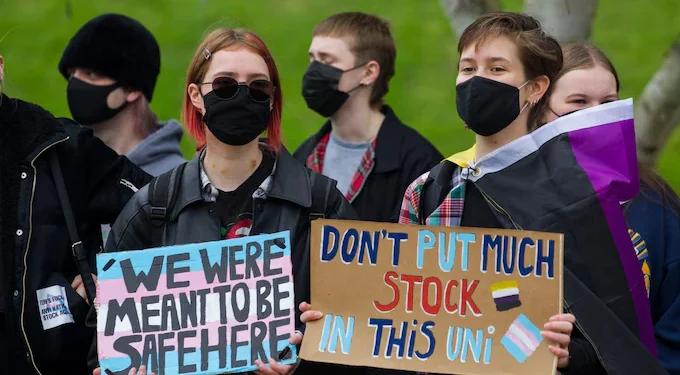Today the census published data on sexual orientation and gender identity for the first time. Census participants were asked “Is the gender you identify with the same as your sex registered at birth?”
94.0% of the population aged 16 years and over answered the question, 93.5% answered yes, 0.5% answered no (equivalent to 262,000 people in England and Wales). This is one in every 200 adults, fairly close to the previous unofficial estimate I had of one in 300.
Those who indicated that their gender identity was different from their sex registered at birth were asked a follow-up write-in question which only half of them answered:
- 0.1% identified as a trans man (approximately 48,000 people)
- 0.1% identified as a trans woman (48,000)
- 0.06% identified as non-binary (30,000)
- 0.04% wrote in a different gender identity (18,000).
Whilst we are now a little bit clearer about the size of the trans population, as the question was optional, and non-response was significant, we still don’t have a precise answer. Perhaps we need to recognise that some people don’t want their identity to be pinned down.
Full results are available on the Census website, which provides regional data as well.
Eight out of the 10 local authorities with the largest proportion of the population whose gender identity was different from their sex at birth were in London. Newham and Brent topped the list. The top two non-London local authorities were Oxford and Norwich. Brighton and Hove, Norwich and Cambridge had the highest proportions writing in non-binary.
For many of us these results will come as no surprise, given that we will have one or two trans people in our wider circle of friends and acquaintances. Generally their gender identity is immaterial in most circumstances. In my own case this includes someone I buy diesel from at the local garage and someone else who has been part of the local anti-lockdown campaign. We have never discussed their gender identity and have no reason to do so.
In the past year I have, however, encountered a larger number of people angrily accusing others of being fascists whilst proclaiming ‘trans rights are human rights’. At a Women’s Rights rally in Brighton last September the people who had come to listen to speakers talking about the importance of single sex spaces and other topics were separated from a group of protestors by a police cordon. The protestors were standing up for ‘trans rights’ and tried to drown out the speakers. Many were masked; some were dressed ‘antifa -like’ entirely in black.
Having attended two such events, I am as yet unclear as to what ‘rights’ the trans campaigners were shouting about. One had a placard saying they (singular) had the right to be gorgeous. I do not remember this being in the UN Convention on Human Rights. Some seemed to be very angry. When the women who wanted single sex spaces tried to talk to the protestors many found that dialogue was impossible.
I am pleased that the Census has provided some data on this. Minority rights are important. Whilst the size of the minority should not have any bearing on the importance of their rights, it does have some bearing on the nature of the public dialogue, especially when two rights conflict. This is the case with single sex spaces or sports and gender identity. Sex and gender (definition-wise) are not the same.
The census will hopefully provide some ‘official clarity’ on the subject. It first ‘came across my desk’ around five years ago when I was part of a technical group overseeing changes to the National Readership Survey. We were asked by the Chair “how would trans people express their gender”. The answer should have been simple: “We observe and record sex (we don’t ask gender) such that we are consistent with the census” (which at that time reported sex not gender). Much time was spent figuring out what to do. Sometimes discussions got a bit heated. When we did introduce a question about gender identity, in my mind it caused more problems than it solved. There was no constructive help from the person who asked the question. At the time they (singular) were also Chair of Stonewall (involved in moving the equality organisation from campaigning solely for lesbian, gay and bisexual people to include trans people). I am aware this move is not very popular with some lesbian and gay men and women and can understand why.
The Census also provides numbers on sexual orientation for the first time:
- 92.5% of participants answered the question
- 43.4 million people (89.4%) identified as straight or heterosexual
- 1.5 million people (3.2%) identified with an LGB+ orientation (“Gay or Lesbian”, “Bisexual” or “Other sexual orientation”).
The figures support the view that gender identity and sexual orientation are different matters, even if they overlap for some people. Hopefully this will help underpin future discussions about gender identity and these will be able to take place in a civilised manner. Dialogue is a natural partner of free speech without which the world becomes divided and dogmatic. That is something most of us do not want.
Nigel Jacklin is a statistician and market researcher who founded The Democratic Network, which helps people get involved in democratic decision-making. Find him on Twitter.
Stop Press: Stonewall has egg on its face, having claimed in a document entitled ‘The Truth About Trans’, that the trans population of the U.K. is 600,000. Steerpike in the Spectator has more.











To join in with the discussion please make a donation to The Daily Sceptic.
Profanity and abuse will be removed and may lead to a permanent ban.